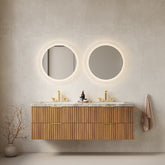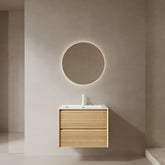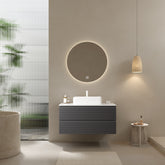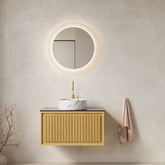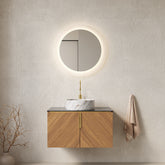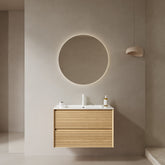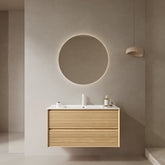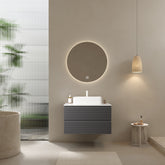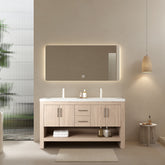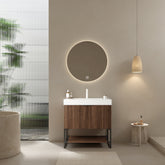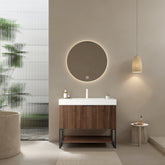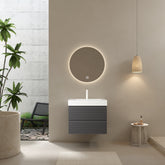Mirror, Lighting, and Vanity: The Perfect Trio for Bathroom Design
Introduction
When it comes to bathroom design, there are three key elements that stand out as essential to creating both style and functionality: mirrors, lighting, and vanities. These three components play a pivotal role in transforming a bathroom from a simple, utilitarian space into a beautifully coordinated and highly functional retreat. But it’s not just about picking any mirror, light, or vanity – it’s about how they work together to create a harmonious and inviting atmosphere.
As someone who’s always looking for ways to improve my own bathroom space, I can tell you that the right combination of bathroom mirrors, vanities, and lighting fixtures can completely elevate the look and feel of the room. Whether you're renovating an old bathroom or designing a brand new one, the synergy between these elements can make all the difference. Proper lighting enhances the beauty of your bathroom vanity and highlights the details of your bathroom mirror, while the right mirror can reflect both light and design, making the space feel more open and spacious.
In this article, we’ll explore how these three components work in unison to create the perfect bathroom design, offering both practical functionality and aesthetic appeal. Whether you’re aiming for a modern, minimalist look or something more luxurious, understanding how to pair mirrors, lighting, and vanities can lead to a bathroom that’s not only beautiful but truly serves your needs.

The Role of Mirrors in Bathroom Design
When it comes to bathroom design, mirrors are far more than just practical tools—they’re essential pieces that help define the entire look and feel of the space. Personally, I’ve always been fascinated by how a simple bathroom mirror can do so much more than just show my reflection. Mirrors serve both functional and decorative purposes, making them one of the most versatile elements in bathroom design.
Functionality: More Than Just a Reflection
Of course, the primary function of a mirror in any bathroom is to provide a clear reflection, whether it’s for grooming, applying makeup, or simply checking yourself out before you head out the door. But mirrors also contribute to the bathroom's functionality by enhancing the overall lighting. A well-placed mirror can reflect both natural light and artificial light, which helps brighten up the space—especially in smaller bathrooms that may not get enough light. This makes mirrors a crucial element for creating a well-lit, functional environment, while also offering a convenient spot for everyday tasks.
Types of Mirrors: Choosing the Right Style
Not all mirrors are created equal, and selecting the right type can have a huge impact on the bathroom design as a whole. Here are a few of the most popular types of mirrors:
- Framed Mirrors: Classic and versatile, framed mirrors add a touch of elegance to any bathroom. The frame can match your bathroom vanity or contrast with it for a bold statement.
- Frameless Mirrors: For a sleek, modern look, frameless mirrors are a great option. They provide a minimalist aesthetic that works well with contemporary bathroom vanities and offer a clean, seamless appearance.
- LED Mirrors: These mirrors are a game-changer when it comes to lighting. With built-in LED lighting around the mirror’s edges, they offer enhanced visibility, making them ideal for tasks like shaving or makeup application. They’re also energy-efficient, which is a nice bonus for any bathroom renovation.
Design Impact: Reflecting Light and Space
One of the most fascinating aspects of mirrors in bathroom design is their ability to alter the perception of space. In my own experience, I’ve noticed that strategically placing a mirror can make a bathroom feel much larger and brighter. This is especially useful in small or windowless bathrooms, where maximizing natural light is important. By reflecting both natural light and artificial light sources, mirrors help create the illusion of space and airiness, making the bathroom feel more open and inviting.
In addition to their practical uses, mirrors also enhance the decorative appeal of a bathroom. They serve as focal points that can complement or contrast with the other elements, like your vanity and lighting. Whether you opt for a bold, ornate mirror or a simple, sleek design, mirrors can elevate the overall aesthetic, bringing balance and harmony to the space.
Ultimately, mirrors are an indispensable part of bathroom design, offering both functional benefits and design impact that can transform your bathroom into a beautiful and well-lit space.

Lighting: Setting the Mood and Providing Utility
When it comes to bathroom design, lighting is more than just a functional necessity—it plays a pivotal role in creating the right atmosphere and enhancing the overall design. From soft, relaxing lighting to bright, task-oriented fixtures, the right bathroom lighting can make a world of difference. Personally, I’ve come to realize that lighting not only sets the mood but also serves a practical purpose, especially in areas like the vanity or near a bathroom mirror.
Types of Bathroom Lighting: Ambient, Task, and Accent Lighting
In any bathroom, it’s essential to have the right mix of different types of lighting to ensure both functionality and style. The three main types of bathroom lighting are:
- Ambient Lighting: This is your general, overall lighting that fills the room. It’s the foundation of your bathroom’s lighting scheme and provides even illumination across the entire space. Recessed ceiling lights or a central overhead light fixture are common choices for ambient lighting.
- Task Lighting: As the name suggests, task lighting is focused on providing adequate lighting for specific activities, such as grooming or makeup application. This is where vanity lighting comes into play. Bright, focused lighting placed around the bathroom mirror ensures that you can clearly see every detail during these tasks.
- Accent Lighting: Accent lighting is used to highlight particular features of the bathroom, such as a decorative vanity or artwork. It adds depth and dimension to the space and can also be used to create a relaxing atmosphere with soft, ambient light. LED strip lights under vanities or around mirrors are popular options for accent lighting.
Lighting for Different Areas: Vanity, Mirror, and Overhead
When I was designing my own bathroom, I quickly realized that lighting needs to be tailored to specific areas. Each zone of the bathroom has different requirements:
- Vanity Lighting: This is the most important area to get right, as it's where you’ll be performing most grooming tasks. Ideally, you want task lighting around the vanity that’s bright, even, and free of harsh shadows. Wall-mounted lights on either side of the vanity mirror or overhead fixtures can work wonders in this area.
- Mirror Lighting: A well-lit mirror is key to getting your reflection just right, whether you’re shaving, applying makeup, or brushing your teeth. Adding LED lighting around the mirror’s edges or installing lights above it can ensure optimal visibility without casting unflattering shadows.
- Overhead Lighting: While it’s important to have ambient lighting that illuminates the entire bathroom, I’ve found that placing a few ceiling lights or a central fixture can also add style to the room. These can be designed to complement the overall aesthetic of the space while providing adequate light for the whole bathroom.
Energy-efficient Lighting: Saving Energy Without Sacrificing Style
As much as I love the idea of creating a stunning bathroom design, I’m also conscious about energy consumption. That’s why I always recommend choosing energy-efficient lighting options, like LED lights, for your bathroom. Not only do they use less electricity, but they also last much longer than traditional incandescent bulbs, saving you both money and hassle in the long run.
LED lighting is particularly great for bathroom mirrors and vanities because it provides bright, clear light without generating heat. Additionally, many LED options are dimmable, giving you the flexibility to adjust the lighting depending on your needs—whether you’re in need of bright task lighting or a softer, more relaxing ambiance for a long soak in the tub.
By incorporating energy-efficient lighting into your bathroom design, you can enjoy the benefits of bright, functional lighting while keeping your energy bills in check.

Vanities: The Centerpiece of the Bathroom
In my experience, when it comes to bathroom design, vanities are often the focal point of the entire space. Not only do they offer crucial storage and organization, but they also play a significant role in shaping the overall look and feel of the bathroom. From sleek, modern designs to more traditional, ornate styles, the right vanity can completely transform your bathroom’s aesthetic and functionality.
Functionality and Storage: Keeping Things Organized
One of the primary reasons bathroom vanities are so important is their ability to provide essential storage. Whether you have a small powder room or a spacious master bath, a vanity can help keep all your bathroom essentials neatly tucked away. In my own bathroom, I’ve found that having sufficient storage in the vanity allows me to keep counters clutter-free, which not only looks better but also makes the space feel more organized and functional.
From drawers and shelves to cabinets and pull-out organizers, modern vanities offer a wide range of storage solutions that cater to different needs. If you’re anything like me, you appreciate having a place for everything, especially in a space that tends to accumulate toiletries, cleaning supplies, and towels. A vanity with multiple compartments can help ensure everything has its place, keeping your bathroom tidy and easy to use.
Design Considerations: Choosing the Right Style
The design of your vanity is arguably one of the most impactful choices you’ll make for your bathroom. The right style can complement the other elements in the room, from the mirror to the lighting to the overall bathroom theme. Here are a few popular vanity styles to consider:
- Modern Floating Vanities: These vanities are a great choice if you’re aiming for a contemporary, minimalist look. Floating vanities are mounted to the wall, creating a sense of openness and making the bathroom feel larger. Plus, they’re ideal for showcasing beautiful flooring beneath them, adding an extra layer of style.
- Freestanding Vanities: For a more traditional or rustic look, freestanding vanities are a solid option. These vanities rest on the floor and often come with decorative legs or bases, which can add charm and elegance to the space.
- Integrated Sink Designs: Integrated sink vanities feature a seamless design where the sink is built directly into the countertop. This style gives a sleek, uniform look that is both modern and easy to maintain. The absence of seams or edges where water can collect makes cleaning a breeze, making it a functional yet stylish choice.
Material and Finish: How Materials Impact Your Bathroom’s Aesthetic
The material and finish of your vanity can have a huge impact on the overall aesthetic of your bathroom. When I was choosing my vanity, I spent a lot of time considering the materials that would work best with the style I was going for. Here are some common materials used in vanities and how they affect the bathroom design:
- Wood: Wood is a classic choice that adds warmth and texture to the bathroom. Whether you go for a light oak or a darker mahogany, wood vanities bring a natural, timeless feel to the space. The finish you choose—matte, glossy, or distressed—can make a big difference in how the vanity blends with the rest of the bathroom.
- Metal: For a more industrial or modern bathroom, metal vanities can be an excellent option. Stainless steel or brass vanities can offer a sleek, contemporary look that pairs well with other modern elements, like a frameless mirror or LED lighting.
- Glass: Glass vanities, especially those with frosted or etched designs, can lend an airy, light feel to the bathroom. They’re often used in more contemporary bathrooms and can pair beautifully with floating vanity designs for a chic, minimalist look.
Ultimately, the material you choose for your vanity should not only align with your style preferences but also be practical for your bathroom’s needs. If you have a high-traffic bathroom or one that’s exposed to a lot of moisture, it’s important to select materials that can withstand humidity and frequent use.
When it comes down to it, the vanity is truly the centerpiece of your bathroom. It combines storage, style, and functionality, making it an essential piece that ties the whole design together. Whether you’re after a modern floating vanity or a traditional freestanding piece, the right vanity will enhance both the practicality and beauty of your bathroom space.

Creating a Cohesive Bathroom Design
When I think about bathroom design, one of the key principles I always keep in mind is creating a cohesive space. After all, a bathroom isn’t just about individual elements; it’s about how everything comes together. That’s why mirrors, lighting, and vanities need to complement each other, working in harmony to create a functional and aesthetically pleasing environment. In this section, I’ll share some tips for bringing these key elements together to achieve a bathroom design that feels seamless and unified.
Design Harmony: Complementing Mirrors, Lighting, and Vanities
The first step in creating a cohesive bathroom design is ensuring that the mirror, lighting, and vanity all work together. I’ve learned that when these elements align, they elevate the entire space. For example, if you have a sleek, modern vanity, it’s important to pair it with a mirror and lighting that reflect the same contemporary style. A minimalist, frameless mirror with clean lines might be the perfect complement to a floating vanity and recessed lighting, creating a sophisticated, modern look.
On the other hand, if you’re going for a more traditional or rustic bathroom, you can balance out a classic, wood-finished vanity with a framed mirror that matches the warm tones of the wood, and soft, ambient lighting to complete the cozy, inviting atmosphere. The key here is ensuring that none of the elements feel out of place; everything should feel like it belongs together, contributing to the overall design vision.
Choosing the Right Pairings: Matching Vanities with Mirrors and Lighting
One of the most enjoyable (and sometimes challenging) parts of bathroom design is selecting the right pairings for your vanity, mirror, and lighting fixtures. For me, I always start by thinking about the overall style I want to achieve. Once I’ve settled on that, I can choose pieces that not only match but enhance the style of the room.
- Vanity and Mirror Pairing: The bathroom mirror should complement the vanity in both style and size. For example, if you’ve chosen a large, bold vanity with a lot of character, a larger mirror can help balance the space. For a more subtle vanity, a smaller or frameless mirror might be the perfect choice. A framed mirror might be ideal for adding texture and interest if the vanity has a simpler design.
- Vanity and Lighting Pairing: When pairing your vanity with lighting, consider the function of the space. If your bathroom needs task lighting (for grooming or makeup), position your lighting fixtures near the vanity for optimal illumination. For a more decorative touch, consider adding accent lighting around the mirror or vanity to highlight key design elements.
Trendy vs. Timeless Designs: Balancing the Two
As with any design project, I’ve found that it’s important to strike a balance between trendy and timeless elements. Trends come and go, but classic design elements tend to remain in style for years. When designing a bathroom, I always think about how the mirror, vanity, and lighting will stand the test of time. For example, while bold, trendy fixtures might be fun to experiment with, opting for a timeless vanity style and neutral lighting can ensure your bathroom design doesn’t feel dated too quickly.
For me, I prefer using timeless elements as the foundation—like a classic wood vanity or a simple, elegant mirror—while incorporating trendy touches through accessories, like lighting fixtures or unique finishes. That way, I get the best of both worlds: a bathroom that feels current and fresh, but won’t look outdated after a few years.
By thoughtfully combining mirrors, lighting, and vanities in a way that complements each other and reflects your personal style, you can create a bathroom that’s both beautiful and functional. Whether you’re leaning towards a trendy design or a more classic approach, the goal is always to create a space that feels harmonious and inviting.

Practical Tips for Selecting the Perfect Trio
When it comes to creating the perfect bathroom design, finding the right combination of mirrors, lighting, and vanities can feel like a challenge, especially when trying to stay within budget and make the most of your space. Over the years, I’ve picked up a few tips that help me navigate this process, whether I'm designing a small powder room or a spacious master bathroom. Below, I’ll share some practical advice on selecting the perfect trio that fits both your style and your needs.
Budget-Friendly Options: Stylish Combinations Without Breaking the Bank
Just because you're working with a budget doesn’t mean you have to compromise on style or functionality. In fact, I’ve discovered that there are plenty of affordable options for mirrors, lighting, and vanities that look just as chic and high-end as pricier choices. Here are a few budget-friendly tips:
- Mirrors: Look for frameless mirrors or simple framed mirrors, which tend to be more affordable yet still very stylish. You can often find high-quality options at budget-friendly prices that still offer a sleek, modern design. A basic LED mirror can also be a great way to add functionality and style without breaking the bank.
- Lighting: When selecting lighting, consider going for more energy-efficient options like LED bulbs, which are often less expensive in the long run and provide great lighting without the high energy costs. Opt for a vanity lighting fixture with a simple design, or even consider installing wall-mounted sconces beside the mirror for a cost-effective yet elegant look.
- Vanities: While it’s tempting to go for a high-end vanity, there are plenty of affordable options that provide excellent storage and style. Look for vanities in durable materials like MDF or plywood, which can be a cost-effective alternative to solid wood. Additionally, freestanding or wall-mounted vanities often offer great value without sacrificing design.
Space Considerations: Tailoring Your Trio to Bathroom Size and Layout
One of the biggest factors to consider when choosing mirrors, lighting, and vanities is the size and layout of your bathroom. In my experience, making the right choice based on available space can greatly impact the room’s functionality and aesthetic. Here are some space-specific tips:
- Small Bathrooms: For smaller bathrooms, it’s important to keep things light and airy. A floating vanity can create a sense of openness, while a framed mirror or a compact LED mirror can help reflect light and make the space feel larger. Opt for smaller, efficient lighting fixtures that don’t overwhelm the room.
- Large Bathrooms: If you’re lucky enough to have a larger bathroom, you can be more adventurous with your choices. Go for a bigger vanity with ample storage, paired with a larger mirror to make a bold statement. Add multiple lighting fixtures for both task and ambient lighting, and consider layering light sources for depth and dimension.
- Oddly Shaped Bathrooms: In bathrooms with unique layouts, I always recommend taking the time to plan the placement of your vanity, lighting, and mirror carefully. Using mirrors to reflect natural light from windows can help brighten up a space, while a freestanding vanity might fit well in a corner without crowding the room.
Expert Advice: Tips for a Cohesive Look
To make sure you’re getting the most out of your bathroom design, I always recommend taking a cue from interior designers. They often offer practical advice that can help you select the best products for a cohesive and stylish bathroom. Here are some expert tips I’ve found helpful:
- Stick to a Consistent Color Scheme: When selecting mirrors, lighting, and vanities, try to stay within the same color palette or finish. For instance, if you choose a dark wood vanity, pair it with a framed mirror that has similar wood tones and complement it with warm-toned lighting fixtures. Consistency in color and material helps create a unified, harmonious space.
- Consider Functionality First: While aesthetics are important, always prioritize the functionality of each element. Choose a vanity that offers sufficient storage, a mirror that suits your daily routine (e.g., a large mirror for grooming), and lighting that provides ample illumination for both task and ambiance.
- Don’t Overcrowd the Space: If you have a smaller bathroom, don’t overdo it with too many fixtures or large items. Sometimes, less is more, and a streamlined, minimal approach can be just as stylish. Consider using floating vanities and sleek mirrors with simple lighting for a clean, modern look.
By keeping these practical tips in mind—whether you’re working with a tight budget or a large space—you can easily select the perfect trio of mirrors, lighting, and vanities that create a beautiful, functional, and cohesive bathroom design. With the right choices, you’ll end up with a space that’s not only stylish but also suits your lifestyle and needs perfectly.

Conclusion
As we’ve explored throughout this article, mirrors, lighting, and vanities truly form the perfect trio when it comes to designing a bathroom that is both functional and aesthetically pleasing. Each of these elements plays a vital role in creating a space that is not only beautiful but also practical. Whether you’re working with a small powder room or a luxurious master bath, the right combination of these three can completely transform your space.
The mirror reflects light and opens up the room, making it feel brighter and larger. The lighting sets the mood and provides the necessary illumination for tasks like grooming, while also enhancing the ambiance of the room. And of course, the vanity serves as the centerpiece, offering both style and storage. Together, these elements create a harmonious and inviting environment that meets both your functional and design needs.
Explore Your Perfect Trio
Now that you have the tools and knowledge to select the right mirrors, lighting, and vanities for your bathroom, it’s time to start experimenting with different combinations. Don’t be afraid to explore various styles, materials, and finishes that reflect your personal taste. Whether you’re going for a sleek, modern look or a cozy, traditional vibe, the right trio can make all the difference in achieving your dream bathroom.
So, take your time, have fun with the process, and feel free to get creative. Your perfect bathroom makeover is just a few thoughtful decisions away. Happy designing!
Featured Products
60" Bathroom Vanity with Sink, Wall-Mounted Bathroom Storage Cabinet with Drawers
- 2,075.00USD
- 2,075.00USD
- Unit price
- / per
30" Wall-Mounted Bathroom Vanity with Ceramic Sink
- 691.00USD
- 691.00USD
- Unit price
- / per
24" Wall-Mounted Bathroom Vanity with Ceramic Sink
- 566.00USD
- 566.00USD
- Unit price
- / per
36" Floating Bathroom Vanity with Vessel Sink
- 783.00USD
- 783.00USD
- Unit price
- / per
30" Wall-Mounted Bathroom Vanity with Sink
- 691.00USD
- 691.00USD
- Unit price
- / per
30" Modern Wall Mounted Bathroom Vanity with Sink
- 585.00USD
- 585.00USD
- Unit price
- / per
30" Floating Bathroom Vanity with Sink
- 628.00USD
- 628.00USD
- Unit price
- / per
36" Wall-Mounted Bathroom Vanity with Ceramic Sink
- 726.00USD
- 726.00USD
- Unit price
- / per
30" Bathroom Vanity with Vessel Sink, Gray Color
- 720.00USD
- 720.00USD
- Unit price
- / per
36" Modern Bathroom Vanity, Wall-Mounted, Natural Walnut Woodgrain Color
- 770.00USD
- 770.00USD
- Unit price
- / per
60" Bathroom Vanity with Sinks, Freestanding Oak Woodgrain Color
- 1,513.00USD
- 1,513.00USD
- Unit price
- / per
30" Freestanding Bathroom Vanity with Sink, Retro Walnut Woodgrain Color
- 865.00USD
- 865.00USD
- Unit price
- / per
36" Freestanding Bathroom Vanity with Sink, Retro Walnut Woodgrain Color
- 920.00USD
- 920.00USD
- Unit price
- / per
24" Bathroom Vanity with Undermount Sink, Gray Color
- 690.00USD
- 690.00USD
- Unit price
- / per
36" Wall-Mounted Bathroom Vanity with Ceramic Sink, Dark Oak Woodgrain Color
- 770.00USD
- 770.00USD
- Unit price
- / per








